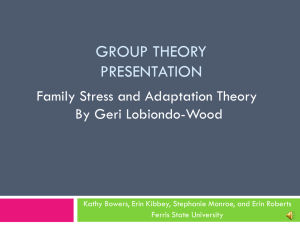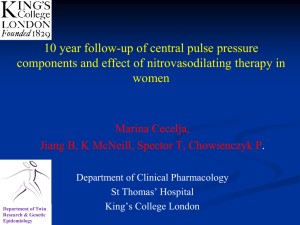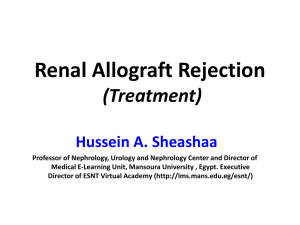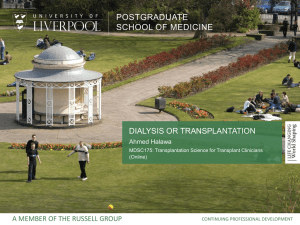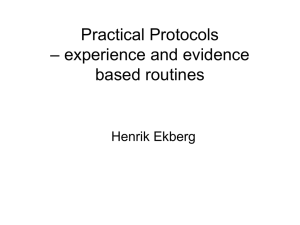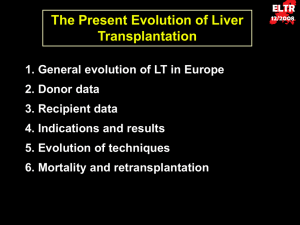Market competition influences renal transplantation and outcomes
advertisement
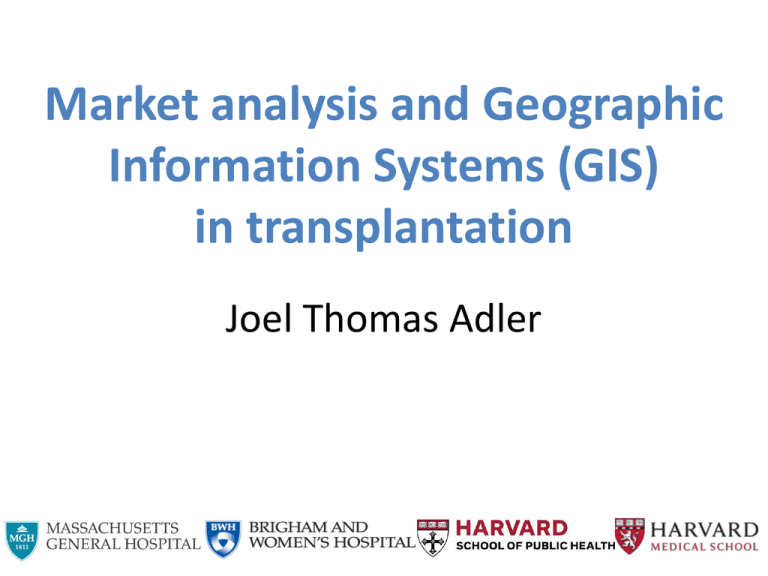
Market analysis and Geographic Information Systems (GIS) in transplantation Joel Thomas Adler Disclosures • Wilmar Chocolates are hand made, hand cut, hand wrapped, and very tasty • Appleton, WI • Please enjoy http://bit.ly/1uWEsCh for chocolate ID Kidney and liver transplantation • 620,000 people with ESRD in the US • 16,000 waiting for liver transplantation Deceased donor liver transplant rates per 100 patient years on the waiting list • Scarcity and allocation • Liver transplant rates greatly vary across country Organ Procurement and Transplant Network Market competition influences renal transplantation and outcomes Joel T. Adler, MD,1,2 Rosh K. V. Sethi, BS,3 Heidi Yeh, MD,2,3 James F. Markmann, MD, PhD,2,3 and Louis L. Nguyen, MD, MBA, MPH1,3,4 1Center for Surgery and Public Health at Brigham and Women’s Hospital of Transplant Surgery, Massachusetts General Hospital 3Harvard Medical School 4Division of Vascular & Endovascular Surgery, Brigham and Women’s Hospital 2Division Competition varies by Donor Service Area (DSA) Outcomes worse in DSAs of higher competition for deceased donors Patient mortality HR (95% CI) P value Graft failure HR (95% CI) P value Competition All patients Living donor Deceased donor 0.99 (0.92, 1.07) 0.78 1.07 (0.99, 1.15) 0.08 0.94 (0.80, 1.11) 0.48 0.99 (0.85, 1.15) 0.89 1.11 (1.02, 1.21) 0.01 1.18 (1.09, 1.28) <0.0001 • Likely not a center-specific effect • Absolute differences small • Better outcomes than dialysis “Markets” and scarce resources • Donor service areas (DSAs) functioning as an individual “market” • Increasing market competition associated with riskier organs and worse survival, but better than alternative • How can we use geography to better understand and optimize? Adler et al Ann Surg 2014 Halldorson et al Liver Trans 2013 Markets and GIS: why does this matter? • Allocation linked to geography • Provide insight into utilization patterns • Justify our definition of DSA markets • Larger discussions of allocation policy Gentry AJT 2013 Geographic Information Systems (GIS) • Integrating geographic information • Long history to understand problems in healthcare • Strength in data layering, combinations, interpolation, and spatial associations GIS in HSR Surgery • Estimating burden of disease in LMIC (Tollefson TT Laryngoscope 2014) • Gunshot trauma (Livingston DH J Trauma Acute Care Surg 2014) • Variation in care (Vassileva C J Heart Valve Dis 2012) • Technology adoption (Sethi J Vasc Surg 2013) Everybody else • Access to stroke care (Adeoye O Stroke 2014) • Need and access in CKD (Rodriguez RA J Nephrol 2013) • Environmental exposures in children (Harrison F Int J Health Geogr 2014) • Health disparities and mammography utilization (Ayanian JZ JNCI 2013) Market competition and density in liver transplantation: relationship to volume and outcome Joel T. Adler, MD1,2, Heidi Yeh, MD2,3, James F. Markmann, MD, PhD2,3, and Louis L. Nguyen, MD, MBA, MPH1,3,4 1Center for Surgery and Public Health at Brigham and Women’s Hospital of Transplant Surgery, Massachusetts General Hospital 3Harvard Medical School 4Division of Vascular & Endovascular Surgery, Brigham and Women’s Hospital 2Division Market competition and density in transplantation • Transplant centers unevenly distributed in the DSAs • Competition and transplant center density are likely important • Incorporate the spatial arrangements into models to better understand access and outcomes ACS 2014, NESS 2014 Density and Organization: Average Nearest Neighbor (ANN) • Geocoded transplant centers • Categorized as clustered, random, or dispersed; single as a special case • Considers spatial arrangement more than distance Average Nearest Neighbor by DSA (Liver) NESS 2014 Market characteristics Variable Population (millions) Liver transplant centers HHI New listings Deceased organ donors Liver transplants MELD score at transplant LDRI Unadjusted Adjusted All DSAs (n = 446) Absolute Nearest Neighbor (ANN) Single Clustered Random Dispersed (n = 150) (n = 164) (n = 93) (n = 39) 5.28 (3.59 – 8.72) 2 (1 – 3) 0.56 (0.50 – 1.00) 166 (98 – 299) 139 (88 – 217) 87.5 (55 – 162) 25.1 ± 0.1 3.33 (2.46 – 4.71) 1 (1 - 1) 1.00 (1.00 – 1.00) 72 (40 – 117) 87 (52 – 131) 48 (23 – 73) 23.3 ± 0.2 6.25 (4.73 – 10.8) 2 (2 – 3) 0.52 (0.39 – 0.61) 220 (161.5 – 425.5) 169.5 (108 – 266) 109 (74.5 – 205) 26.6 ± 0.2 6.34 (4.49 – 9.35) 2 (2 – 4) 0.50 (0.42 – 0.53) 232 (155 – 401) 151 (114 – 257) 131 (85 – 166) 25.8 ± 0.3 8.70 (7.37 – 17.0) 3 (2 – 4) 0.51 (0.31 – 0.59) 285 (168 – 602) 211 (171 – 444) 179 (88 – 436) 23.9 ± 0.3 1.51 (1.44 – 1.57) 1.37 (1.31 – 1.43) 1.44 (1.36 – 1.53) 1.32 (1.25 – 1.39) 1.52 (1.45 – 1.60) 1.39 (1.32 – 1.44) 1.52 (1.49 – 1.59) 1.40 (1.36 – 1.44) 1.54 (1.51 – 1.61) 1.39 (1.35 – 1.43) P value <0.0001 <0.0001 <0.0001 <0.0001 <0.0001 <0.0001 <0.0001 <0.0001 <0.0001 NESS 2014 Liver transplants performed Variable IRR (95% CI) Adult liver transplant centers Competition (inverse HHI) New listings (100s) Donors (100s) Population (millions) Geography (by ANN) Single Clustered Random Dispersed MELD score (at transplant) Adjusted LDRI P value 1.03 (1.01 – 1.06) 1.33 (1.03 – 1.69) 1.14 (1.10 – 1.17) 1.25 (1.17 – 1.32) 1.04 (1.00 – 1.07) 0.04 0.03 <0.0001 <0.0001 0.02 Ref 1.25 (1.13 – 1.38) 1.24 (1.09 – 1.41) 1.43 (1.10 – 1.85) 0.97 (0.96 – 0.98) 3.35 (2.54 – 4.43) <0.0001 0.001 0.007 <0.0001 <0.0001 NESS 2014 Patient and graft outcomes Mortality HR (95% CI) P value Variable Liver transplant centers Competition (inverse HHI) New listings (100s) Donors (100s) Population (millions) Geography (by ANN) Single Clustered Random Dispersed Adjusted LDRI Graft failure HR (95% CI) P value 1.01 (0.98 - 1.04) 0.99 (0.77 – 1.29) 1.02 (0.99 – 1.04) 1.05 (0.99 – 1.10) 0.99 (0.98 – 1.01) 0.68 0.96 0.16 0.04 0.08 1.05 (1.01 – 1.08) 2.17 (1.64 – 2.86) 0.94 (0.91 – 0.97) 1.13 (1.07 – 1.19) 1.03 (1.01 – 1.05) 0.01 <0.0001 <0.0001 <0.0001 0.0002 Ref 1.02 (0.91 – 1.14) 1.03 (0.91 – 1.17) 1.03 (0.91 – 1.17) 1.56 (1.47 – 1.66) - Ref 1.51 (1.34 – 1.71) 1.31 (1.14 – 1.51) 1.01 (0.87 – 1.17) 1.68 (1.56 – 1.80) <0.0001 0.0002 0.90 <0.0001 0.65 0.62 <0.0001 NESS 2014 Conclusions • Market variables and ANN are most important for graft survival • Transplant center density has a measurable impact on liver transplants and patient and graft survival • Increasing the number of liver transplant centers within a DSA could provide better access to liver transplantation Market and socioeconomic factors in the conduct of kidney transplantation Joel T. Adler, MD1,2, Heidi Yeh, MD2,3, James F. Markmann, MD, PhD2,3, and Louis L. Nguyen, MD, MBA, MPH1,3,4 1Center for Surgery and Public Health at Brigham and Women’s Hospital of Transplant Surgery, Massachusetts General Hospital 3Harvard Medical School 4Division of Vascular & Endovascular Surgery, Brigham and Women’s Hospital 2Division Market and socioeconomic factors in the conduct of kidney transplantation • Kidney transplants dependent on market factors (SRTR) • Socioeconomic factors affect access to kidney transplantation (US ACS) • These factors may be spatially correlated to better understand kidney transplantation ASC 2015 (submitted) Competition by ZCTA Competition in the United States ASC 2015 (submitted) Spatial regression • Classically linear (housing prices in Manhattan) • Spatial error – Omitted (spatially correlated) covariate – Errors are not independent • Spatial lag – “Diffusion” process: events in one place predict and increased likelihood of events in other areas – Observations and errors are not independent • Dependent on weights (queen, rook, K nearest neighbor…) Kidney transplants and SES factors are spatially related ----------------------------------------------------------------------Variable Coefficient Std. Error z-value Probability ----------------------------------------------------------------------CONSTANT 40.56982 4.683726 8.661868 0.0000000 HHI_HSA_IN 27.54952 1.712949 16.0831 0.0000000 CROWDED 1.16356 0.2482719 4.686636 0.0000028 POVERTY -0.1164395 0.1354502 -0.8596483 0.3899829 LOW_EDUCAT -0.05833486 0.1134684 -0.5141065 0.6071775 HIGH_EDUCA 0.3939563 0.1205663 3.267548 0.0010850 UNEMPLOYME 0.8934559 0.2050763 4.356701 0.0000132 MPV -3.4443e-005 7.431e-006 -4.633904 0.0000036 MHI -9.5672e-005 7.181e-005 -1.332215 0.1827895 LAMBDA 0.459516 0.02209419 20.79805 0.0000000 ----------------------------------------------------------------------- ASC 2015 Conclusions • Competition and SES effects diffuse among neighboring HSAs • Spatial autocorrelation plays a role in factors influencing kidney transplantation • Consider these issues in planning transplant center location and organ sharing ASC 2015 (submitted) Conclusions: this does matter! • Allocation and utilization are linked to geography • Utilization patterns and cost • Justify our definition of DSA markets • Allocation policy Gentry AJT 2013 Resources • Center for Geographic Analysis (http://www.gis.harvard.edu/) • Open GeoDA (https://geodacenter.asu.edu/ogeoda) • ESRI ArcGIS (http://www.esri.com/software/arcgis) Three boys? Why not? | ̄ ̄ ̄ ̄ ̄ ̄ | | JANUARY 24 | | | | (SIGN BUNNY) | | _______| (\__/) || (•ㅅ•) || / づ Projects • ZIP codes and SES of donors and recipients • Spatial organization of centers – Kidney transplants – Liver transplants • • • • Competition maps and access to transplantation Market competition density index Provider-induced demand Disparities in donation rates (Bode) GIS tools • • • • • Data display and interpretation Combining data and interpolating Hotspot/outlier analysis Organization of points Spatial regression Low-quality kidneys are used in more competitive DSAs Variable OR (95% CI) Competition None P value 1.00 - Low 1.20 (1.08, 1.32) 0.0005 Medium 1.05 (0.95, 1.16) 0.33 High 1.39 (1.26, 1.52) <0.0001 Average Nearest Neighbor by DSA (Kidney) ACS 2014 Hotspot/outlier analysis for competition: Local Indicator of Spatial Autocorrelation (LISA) ASC 2015 (submitted) Display and interpretation Overview • Transplantation and markets: competition and outcomes • Geographic Information Systems (GIS) • GIS in HSR • GIS techniques and how we’ve used them • Future directions

